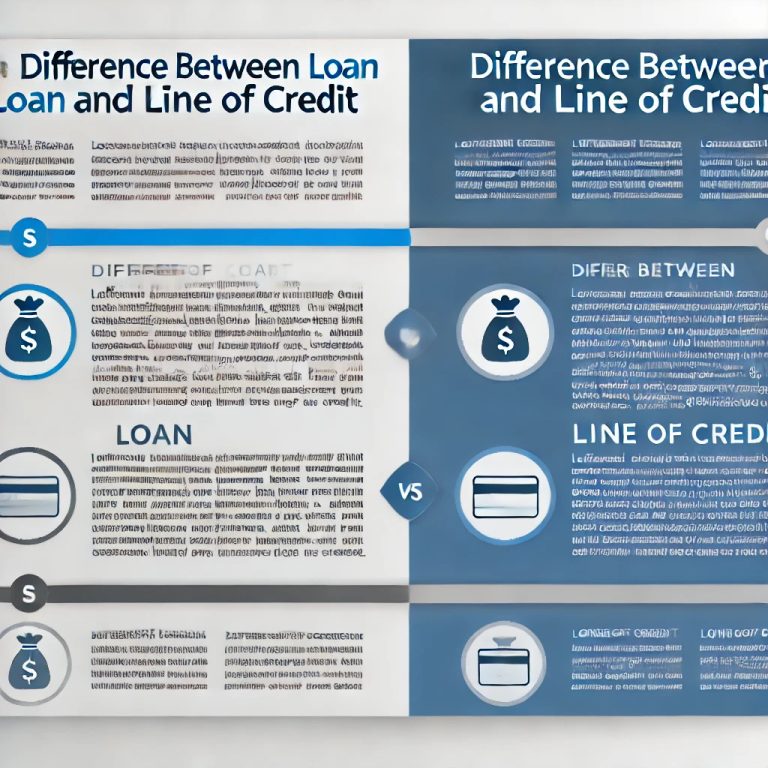The Difference Between Loan and Line of Credit lies in their structure, repayment terms, and usage flexibility. A loan is a fixed amount borrowed for a specific purpose, repayable in installments, while a line of credit is a flexible borrowing arrangement allowing access to funds as needed. Both serve distinct financial needs, making it essential to understand their characteristics for better financial planning. This article explores their definitions, types, and key differences to guide your decision-making process.
What is Loan?
A loan is a fixed amount of money borrowed from a lender, with a set repayment schedule that includes principal and interest payments. It is typically used for specific purposes such as purchasing a home, vehicle, or funding education.
- Fixed Amount: Borrowers receive the entire loan amount upfront.
- Repayment Schedule: Repayments are made over a predetermined period.
- Interest Rate: Can be fixed or variable.
- Purpose-Specific: Often tied to specific needs like home loans or car loans.
Example:
If a borrower takes out a $50,000 car loan at a 5% interest rate over 5 years, they repay the principal and interest in equal monthly installments.
Types of Loans
Types of loans include secured loans, backed by collateral; unsecured loans, based on creditworthiness; personal loans for general needs; and business loans, for company funding.
- Secured Loans: Backed by collateral (e.g., property, car). Lower interest rates due to reduced risk for lenders. Examples: Mortgage, auto loans.
- Unsecured Loans: No collateral required. Higher interest rates. Examples: Personal loans, student loans.
- Fixed-Rate Loans: Interest rate remains constant throughout the loan term. Predictable repayment amounts.
- Variable-Rate Loans: Interest rates fluctuate based on market conditions. Payments may vary over time.
Comparison Table
| Loan Type | Key Feature | Examples |
| Secured Loan | Requires collateral | Mortgage, car loans |
| Unsecured Loan | No collateral, higher risk | Personal loans, credit cards |
| Fixed-Rate Loan | Consistent interest rate | Long-term mortgages |
| Variable-Rate Loan | Interest rate changes with market | Home equity loans |
What is Line of Credit?
A line of credit is a flexible borrowing arrangement where the lender provides a credit limit, and the borrower can withdraw funds as needed up to that limit. Interest is charged only on the amount used.
- Credit Limit: Specifies the maximum amount available.
- Revolving Nature: Funds become available again after repayment.
- Interest on Usage: Only the borrowed amount incurs interest.
- No Fixed Purpose: Funds can be used for various needs.
Example:
A business with a $20,000 credit line may withdraw $10,000, leaving $10,000 available. If they repay $5,000, their available balance increases to $15,000.
Types of Credit Lines
There are personal lines of credit, used by individuals for personal purposes, business lines of credit, which aid in firm needs, and home equity lines of credit or HELOCs, value the property.
- Secured Line of Credit: Backed by collateral (e.g., home equity). Lower interest rates due to reduced risk.
- Unsecured Line of Credit: No collateral required. Higher interest rates compared to secured credit lines.
- Personal Line of Credit: Used for individual financial needs like medical bills or education.
- Business Line of Credit: Provides businesses with liquidity to manage cash flow or unexpected expenses.
Comparison Table:
| Credit Line Type | Purpose | Key Feature |
| Secured Line of Credit | Backed by assets | Lower interest rates |
| Unsecured Line of Credit | No collateral | Higher risk, flexible usage |
| Personal Line of Credit | Individual financial needs | Easy access for emergencies |
| Business Line of Credit | Working capital for businesses | Helps manage cash flow |
Difference Between Loan and Line of Credit
A loan offers a lump amount with a fixed repayment cycle, while a line of credit is more fluid-borrowing up to a predefined amount or credit limit.
| Aspect | Loan | Line of Credit |
| Structure | Fixed amount disbursed upfront | Flexible access up to a credit limit |
| Repayment | Regular installments | Pay as you use |
| Interest | Charged on full loan amount | Charged only on amount used |
| Purpose | Often purpose-specific | Multi-purpose |
| Flexibility | Inflexible | Highly flexible |
Example Comparison: A loan might be used to purchase a house with fixed monthly repayments. A line of credit could be used for ongoing expenses, such as home renovations, where funds are withdrawn and repaid as needed.
Conclusion
The Difference Between Loan and Line of Credit is significant for borrowers seeking financial solutions. Loans are ideal for large, one-time expenses with predictable repayment schedules, while lines of credit offer flexibility for recurring or unforeseen needs. Understanding their distinct features helps individuals and businesses make informed choices based on financial goals and circumstances. Both options are valuable tools when used strategically.
Difference Between Loan and Line of Credit FAQs
What is the main difference between a loan and a line of credit?
A loan is a lump-sum amount disbursed upfront, while a line of credit allows borrowing as needed up to a credit limit.
Are loans or lines of credit better for emergencies?
Lines of credit are better for emergencies due to their flexibility and revolving nature.
Can I use a line of credit for business purposes?
Yes, a business line of credit is specifically designed to meet a company’s financial needs.
Is the interest rate higher on a loan or a line of credit?
Lines of credit typically have higher interest rates than secured loans, but you only pay interest on the amount used.
Which is more flexible, a loan or a line of credit?
A line of credit is more flexible as it allows borrowing as needed and repayments restore available credit.


